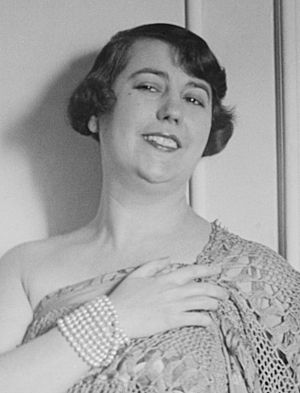Elvira de Hidalgo facts for kids
Quick facts for kids
Elvira de Hidalgo
|
|
|---|---|

Elvira de Hidalgo, 1920s.
|
|
| Born |
Elvira Juana Rodríguez Roglán
28 December 1891 |
| Died | 21 January 1980 (aged 88) |
| Occupation |
|
Elvira Juana Rodríguez Roglán (born December 28, 1891 – died January 21, 1980) was a famous Spanish opera singer. She was known professionally as Elvira de Hidalgo. She sang with a high voice type called a coloratura soprano. Later in her life, she became a teacher and helped other singers improve their voices. Her most famous student was the legendary opera singer Maria Callas.
Contents
Early Life and Training
Elvira de Hidalgo was born in Valderrobres, a town in Aragon, Spain. Her parents were Pedro Rodríguez Hidalgo and Miguela Roglán Bel.
She began her music studies in Barcelona with a teacher named Concepció Bordalba. Later, she moved to Milan, Italy, to study with Melchiorre Vidal. Vidal was a well-known teacher who also taught many other famous singers of that time.
Opera Career Highlights
Elvira de Hidalgo made her first professional appearance at just sixteen years old. This happened at the Teatro di San Carlo in Naples, Italy. She sang the role of Rosina in the opera The Barber of Seville. This role became her most famous one.
After her first performance, she quickly got invitations to sing in other big cities. She performed in Paris, where she sang Rosina alongside the famous singer Feodor Chaliapin. She also sang in Monte Carlo, Prague, and Cairo.
Singing in America
Elvira de Hidalgo made her debut at the Metropolitan Opera in New York City in 1910. Again, she sang the role of Rosina. During that same season, she performed in other operas like Rigoletto with Enrico Caruso and La sonnambula.
She returned to the Met in 1924-1925. She sang in The Barber of Seville, Rigoletto, and Lucia di Lammermoor. After her New York debut, she also sang in Florence, Italy, and in Rome. In 1913, she performed in St. Petersburg, Russia.
Performances in Europe and Beyond
In 1916, she sang for the first time at La Scala in Milan, one of the world's most famous opera houses. She returned there in 1921. The next year, de Hidalgo performed in Buenos Aires, Argentina, at the Teatro Colón. She sang in Rigoletto, La traviata, and The Barber of Seville.
In 1924, she performed in London at Covent Garden. She also sang at the Royal Albert Hall with the London Symphony Orchestra. That same year, she sang in Chicago. In 1926-1927, she toured the United States and Canada with Feodor Chaliapin, performing The Barber of Seville.
Recordings
Elvira de Hidalgo made several recordings during her career. She recorded for Columbia Records in 1907-1908. These recordings included songs from The Barber of Seville, La sonnambula, and I puritani.
From 1909 to 1910, she made recordings for Fonotipia. These included parts from many operas like Don Pasquale, Roméo et Juliette, and L'elisir d'amore. She also returned to the recording studio later in her career. You can hear her singing in a famous collection called The Record of Singing.
Teaching Career
Elvira de Hidalgo started teaching singing in 1933. She later taught at the Athens Conservatoire in Greece. It was there that a young singer named Maria Callas became her student.
Maria Callas became one of the greatest opera singers of all time. In 1957, Callas wrote about how important Elvira de Hidalgo was to her. She said that de Hidalgo played a "very important role" in her artistic training. Callas also wrote that her teacher gave her "her whole heart." This shows how much Elvira de Hidalgo cared for her students.
Later Life and Legacy
Elvira de Hidalgo passed away in Milan, Italy, in 1980. She was first buried in a temporary grave. In 1990, her students and friends paid to move her remains to a more permanent cemetery in Milan.
Later, in 2018, her remains were moved again. They were brought back to her hometown in Spain, Valderrobres. A special event was held to honor her, including a concert and an exhibition about her life at the Valderrobres Museum. A plaque was also placed on her childhood home.
See also
 In Spanish: Elvira de Hidalgo para niños
In Spanish: Elvira de Hidalgo para niños

